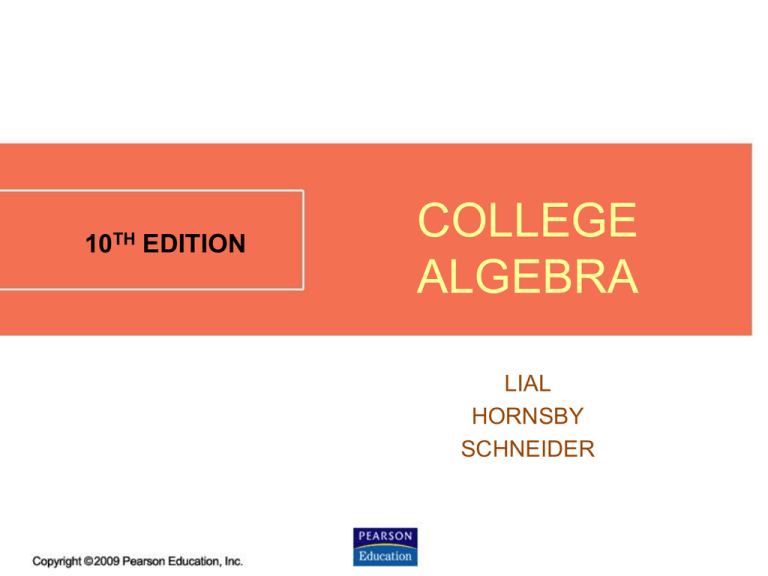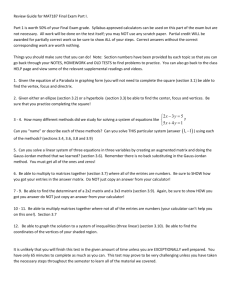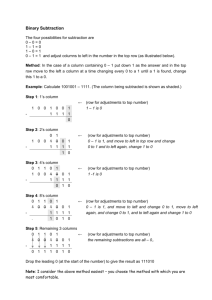Matrix Solution of Linear Systems
advertisement

10TH
EDITION
COLLEGE
ALGEBRA
LIAL
HORNSBY
SCHNEIDER
5.2 - 1
Matrix Solution of Linear Systems
5.2
The Gauss-Jordan Method
Special Systems
5.2 - 2
Matrix Solutions
Since systems of linear equations occur in so
many practical situations, computer methods
have been developed for efficiently solving linear
systems. Computer solutions of linear systems
depend on the idea of a matrix (plural matrices),
a rectangular array of numbers enclosed in
brackets. Each number is called an element of
the matrix.
5.2 - 3
Gauss-Jordan Method
Matrices in general are discussed in
more detail later in this chapter. In this
section, we develop a method for
solving linear systems using matrices.
As an example, start with a system and
write the coefficients of the variables
and the constants as a matrix, called
the augmented matrix of the system.
5.2 - 4
Gauss-Jordan Method
Linear system of equations
x 3 y 2z 1
2x y z 2
xy z2
5.2 - 5
Gauss-Jordan Method
The vertical line, which is optional,
separates the coefficients from the
constants. Because this matrix has 3
rows (horizontal) and 4 columns
(vertical), we say its size is 3 4 (read
“three by four”). The number of rows is
always given first. To refer to a number
in the matrix, use its row and column
numbers.
5.2 - 6
Matrix Row Transformations
For any augmented matrix of a system of linear
equations, the following row transformations will
result in the matrix of an equivalent system.
1. Interchange any two rows.
2. Multiply or divide the elements of any row by a
nonzero real number.
3. Replace any row of the matrix by the sum of
the elements of that row and a multiple of the
elements of another row.
5.2 - 7
Gauss-Jordan Method
These transformations are just
restatements in matrix form of the
transformations of systems discussed in
the previous section. From now on, when
referring to the third transformation, “a
multiple of the elements of a row” will be
abbreviated as “a multiple of a row.”
5.2 - 8
Gauss-Jordan Method
The Gauss-Jordan method is a systematic
technique for applying matrix row transformations in
an attempt to reduce a matrix to diagonal form,
with 1s along the diagonal, such as
from which the solutions are easily obtained. This
form is also called reduced-row echelon form.
5.2 - 9
Using the Gauss-Jordan Method
to Put a Matrix Into diagonal Form
Step 1 Obtain 1 as the first element of the first
column.
Step 2 Use the first row to transform the remaining
entries in the first column to 0.
Step 3 Obtain 1 as the second entry in the second
column.
Step 4 Use the second row to transform the
remaining entries in the second column to 0.
Step 5 Continue in this manner as far as possible.
5.2 - 10
Note The Gauss-Jordan method
proceeds column by column, from left
to right.
When you are working with a particular
column, no row operation should undo the
form of a preceding column.
5.2 - 11
USING THE GAUSS-JORDAN
METHOD
Solve the system.
Example 1
3 x 4y 1
5 x 2y 19
Solution
Both equations are in the same form, with variable
terms in the same order on the left, and constant
terms on the right.
Write the augmented matrix.
5.2 - 12
USING THE GAUSS-JORDAN
METHOD
The goal is to transform the augmented matrix
into one in which the value of the variables will
be easy to see. That is, since each column in
the matrix represents the coefficients of one
variable, the augmented matrix should be
transformed so that it is of the form for real
numbers k and j. Once the augmented matrix is
in this form, the matrix can be rewritten as a
linear system to get
Example 1
xk
This form is our
goal.
y j.
5.2 - 13
USING THE GAUSS-JORDAN
METHOD
It is best to work in columns beginning in each
column with the element that is to become 1.
In the augmented matrix
Example 1
3 is in the first row, first column position. Use
transformation 2, multiplying each entry in the first
row by to get 1 in this position. (This step is
abbreviated as ⅓R1.)
5.2 - 14
Example 1
USING THE GAUSS-JORDAN
METHOD
Introduce 0 in the second row, first column by
multiplying each element of the first row by –5 and
adding the result to the corresponding element in
the second row, using transformation 3.
5.2 - 15
Example 1
USING THE GAUSS-JORDAN
METHOD
Obtain 1 in the second row, second column by
multiplying each element of the second row by
using transformation 2.
3
,
26
5.2 - 16
Example 1
USING THE GAUSS-JORDAN
METHOD
Finally, get 0 in the first row, second column by
multiplying each element of the second row by 4
3
and adding the result to the corresponding
element in the first row.
5.2 - 17
Example 1
USING THE GAUSS-JORDAN
METHOD
This last matrix corresponds to the system
x 3
y 2
that has solution set {(3, 2)}. We can read this
solution directly from the third column of the
final matrix. Check the solution in both
equations of the original system.
5.2 - 18
USING THE GAUSS-JORDAN
METHOD
Solve the system.
Example 2
x y 5z 6
3 x 3 y z 10
x 3 y 2z 5
Solution
5.2 - 19
Example 2
USING THE GAUSS-JORDAN
METHOD
There is already a 1 in the first row, first column.
Introduce 0 in the second row of the first column
by multiplying each element in the first row by – 3
and adding the result to the corresponding
element in the second row.
5.2 - 20
Example 2
USING THE GAUSS-JORDAN
METHOD
To change the third element in the first column to
0, multiply each element of the first row by – 1, and
add the result to the corresponding element of the
third row.
5.2 - 21
Example 2
USING THE GAUSS-JORDAN
METHOD
Use the same procedure to transform the second and third
columns. For both of these columns, perform the additional
step of getting 1 in the appropriate position
of each column. Do this by multiplying the elements of the row
by the reciprocal of the number in that position.
5.2 - 22
Example 2
USING THE GAUSS-JORDAN
METHOD
The linear system associated with this final
matrix is
x 1
y 2
z 1.
The solution set is {(1, 2, –1)}. Check the
solution in the original system.
5.2 - 23
Example 3
SOLVING AN INCONSISTENT
SYSTEM
Use the Gauss-Jordan method to solve the system.
xy 2
2 x 2y 5
Solution
5.2 - 24
SOLVING AN INCONSISTENT
SYSTEM
The next step would be to get 1 in the second
row, second column. Because of the 0 there, it is
impossible to go further. Since the second row
corresponds to the equation 0x + 0y = 1, which
has no solution, the system is inconsistent and
the solution set is ø.
Example 3
5.2 - 25
SOLVING A SYSTEM WITH
INFINITELY MANY SOLUTIONS
Use the Gauss-Jordan method to solve the
system.
Example 4
2 x 5 y 3z 1
x 2 y 2z 8
Solution
Recall from the previous section that a system
with two equations in three variables usually has
an infinite number of solutions. We can use the
Gauss-Jordan method to give the solution with z
arbitrary.
5.2 - 26
Example 4
SOLVING A SYSTEM WITH
INFINITELY MANY SOLUTIONS
It is not possible to go further with the GaussJordan method.
5.2 - 27
SOLVING A SYSTEM WITH
INFINITELY MANY SOLUTIONS
The equations that correspond to the final matrix are
Example 4
x 16z 38
and
y 7z 15.
Solve these equations for x and y, respectively.
x 16z 38
x 16z 38
y 7z 15
y 7z 15
The solution set, written with z arbitrary, is
16z 38, 7z 15, z .
5.2 - 28
Summary of Possible Cases
When matrix methods are used to solve a system of
linear equations and the
resulting matrix is written in diagonal form:
1. If the number of rows with nonzero elements to
the left of the vertical line is equal to the number
of variables in the system, then the system has a
single solution. See Examples 1 and 2.
5.2 - 29
Summary of Possible Cases
2. If one of the rows has the form [0 0 0 a] with
a ≠ 0, then the system has no solution. See
Example 3.
3. If there are fewer rows in the matrix containing
nonzero elements than the number of variables,
then the system has either no solution or infinitely
many solutions. If there are infinitely many
solutions, give the solutions in terms of one or
more arbitrary variables. See Example 4.
5.2 - 30
Applications
Example 1: (p. 333)
A company plans to spend $3 million on 200
new vehicles. Each van will cost $10000,
each small truck $15000, and each large
truck $25000. Past experience shows that the
company needs twice as many vans as small
trucks. How many of each kind of vehicles
can the company buy?
5.2 - 31
Applications
Example 2: (p. 334)
Ellen plans to invest a total of $100000 in a money
market account, a bond fund, an international stock
fund, and a domestic stock fund. She wants 60% of
her investment to be conservative (money market
and bonds). She wants the amount in international
stocks to be one-forth of the amount in domestic
stocks. Finally, she needs an annual return of
$4000. Assuming she gets annual return of 2.5% on
the money market account, 3.5% on the bond fund,
5% on the international stock fund, and 6% on the
domestic stock fund, how much should she put in
each investment?
5.2 - 32
Applications
Example 3:
Kelly Karpet Kleaners sells rug-cleaning machines.
The EZ model weighs 10 pounds and comes in a
10-cubic-foot box. The compact model weighs 20
pounds and comes in an 8-cubic-foot box. The
commercial model weighs 60 pounds and comes in
a 28-cubic-foot box. Each of Kelly’s delivery van
has 248 cubic feet of space and can hold a
maximum of 440 pounds. In order for a van to be
fully loaded, how many of each model should it
carry?
5.2 - 33




